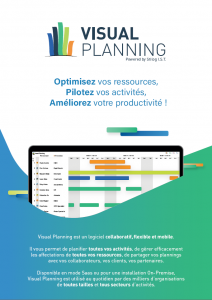Smart resource planning is essential for any business that wants to manage money, assets, and time. With proper resource planning techniques, all of the resources that are needed for a project can be allocated correctly and in the most valuable way. If the right resources are not assigned to the correct task at the correct time, the whole project can stall. Resource scheduling is one of the most important parts of project management and can be the difference between a project being a success or a failure.
Striving to improve your business’s resource scheduling at all times will ensure those vital resources are available when they are needed most. There are several things that organizations can do to achieve better resource scheduling and, as a result, better project outcomes.
What is Resource Scheduling?
Resource scheduling is the process of identifying and coordinating your resources, so they are assigned to the right task at the right time. Resource scheduling requires a start and end date to be set for each task within any given project, considering the availability of resources like employee time, specialized equipment, and facilities, as well as when they will be available to the employees who need them.
Good resource scheduling means that vital resources are neither over nor under allocated, ensuring that all tasks and projects have the appropriate tools to succeed when they need them. This saves time and money by eliminating redundancies, as well as ensuring that critical projects are being completed on time. When projects progress smoothly and are completed successfully, it will also help to improve relationships, profitability, and employee satisfaction.
Benefits of Resource Scheduling
Resource scheduling software delivers a range of benefits for all projects and businesses. Resources are assigned to be used in the most efficient way, considering which resources are best suited and most needed for any task. The more is used, the more data can be gathered to further improve resource scheduling in the future.
Resource scheduling also makes it easier to work out demand and capacity for different resources so that planning in the future can be carried out more accurately. With resource scheduling, any organization can make sure that they have full oversight over the resources that they use. Each step that is taken in resource scheduling helps both current and future projects to run more smoothly and produce better results. Teams will feel better about the projects they work on and place more trust in their project managers when resources are used more efficiently.
Best Practices for Resource Scheduling
Better resource scheduling leads to better project results and more. The following tips will help your organization to improve resource scheduling
1. Identify Tasks and Resources
To get resource scheduling right, you need to be able to accurately identify the tasks that need to be completed and the resources that are available. If you can’t get this step right, you will struggle to carry out any of the other necessary steps. When planning a project, listing the tasks that need to be completed is one of the first things that you need to do. It may seem obvious, but understanding which tasks need to be completed, how long each task might take, and what resources are going to be required is vital to proper resource scheduling.
Resources might include employees, outside contractors, equipment and machinery, or rooms and facilities. It’s necessary to know the capacity of your resources, from how many people a meeting room can hold to how much work your employees are able to complete in a day. Knowing this information makes it possible to accurately assign resources to tasks and predict how long the resources will be needed.
2. Create Accurate Time Estimates
It’s essential to have accurate time estimates for resource scheduling. If you don’t know how long a resource will be required, it could throw off not just one project but other projects that might also require that resource. Guessing at time estimates or creating them without the data and evidence to back them up will often lead to tasks and budgets overrunning.
It’s also important to avoid the risk of inaccurate time estimates due to pressure. Although management or clients might try to rush a job, this could simply lead to being unable to meet the agreed upon due date or simply overall poor results. When accurate time estimates are produced, it will mean that resources are scheduled appropriately, and stakeholders will be happy in the end. Realistic time estimates can be backed up with data from your resource scheduling tools. If you need to demonstrate how a time estimate has been created, you can show clients and managers that you have a strong basis to make the estimate.
3. Create a Risk Management Strategy
Risk management is a necessity for all areas of business. The possibility of something going wrong is an event you need to be prepared for, even though you likely can’t guess when or how it will happen. If something does go wrong, it could mean that a task takes longer or requires certain resources for more time than was initially estimated. It might also involve a resource no longer being available, whether that means broken equipment or a staff member is off sick. Even with careful planning, there could be uncertainty surrounding the availability of some of your resources.
A proper risk management strategy will lead to better resource scheduling. What should happen if something doesn’t go to plan will be built into each project. As well as managing risks to prevent problems from happening, it will allow for the right approach to be taken if something does go wrong. Take the time to understand where issues could make themselves known and what can be done about them. Rather than trying to work with tight constraints where resources, time, and money are concerned, leave room to make changes when necessary. When you incorporate risk into your time estimates, you can schedule resources more accurately.
4. Adapt to Changes
Flexibility is a must and goes hand-in-hand with risk management. If you can no longer use equipment or a room that you had previously scheduled, how are you going to adapt and find the resources that you need? To achieve flexibility with resource scheduling, it may also be necessary to be flexible with other elements of a project too. If the availability of certain resources changes, other parts of the plan might need to adapt too.
Not being able to adapt will make things difficult for everyone. You can’t just expect people to get things done if they don’t have the resources that they expected. Resource scheduling needs to allow for change when necessary so that projects can continue even when they hit a bump. Be open to feedback and advice, which can help you to improve your resource scheduling and solve problems.
5. Use Collaborative Solutions
The right technical solutions make a significant difference when you’re trying to get resource scheduling right. They take a lot of the work out of scheduling, make it easier to keep track of everything, and can provide insights to improve resource scheduling for future projects. Collaborative solutions like Visual Planning ensure that you have all of the tools necessary to get resource scheduling right. With software that suits your needs, you have all of the information necessary to make the right decisions.
When using collaborative solutions for resource scheduling, it’s possible to ensure all data points are considered. Scheduling decisions can be made while considering compliance, budgets, employee skill sets, and more. Scheduling software also helps to reduce errors and create more stable schedules for employees too. Collaborative solutions ensure that everyone stays in the loop and will be updated if any changes are required. This can help to improve morale and get teams working better together. Using these tools can make resource scheduling faster and more accurate, improving things for everyone. The whole team can work together to ensure resources are allocated and scheduled in the best way possible.
Improve Resource Scheduling with the Right Software
The first step toward is making sure that you have the right software, capable of integration with other tools, customization, mobile access, tracking, and reporting.
Collaborative tools like Visual Planning mean that everyone on your team can get involved with resource scheduling, contributing, and taking control of their time. It saves time for individuals and for the organization as a whole. Everyone can see the same information so that they know who should be doing what and updates can be carried out and viewed in real-time.
Integrating with other tools will also help you to make full use of resource scheduling software. Get familiar with the full range of features available from your software, and you can make sure it’s as beneficial as possible to those responsible and all others on your team.
Communicator Journalist with an Organizational Communication master degree specialized in Digital Communication from University Jean Moulin Lyon 3. Passionate about new technologies, social medias, marketing and cooking.



